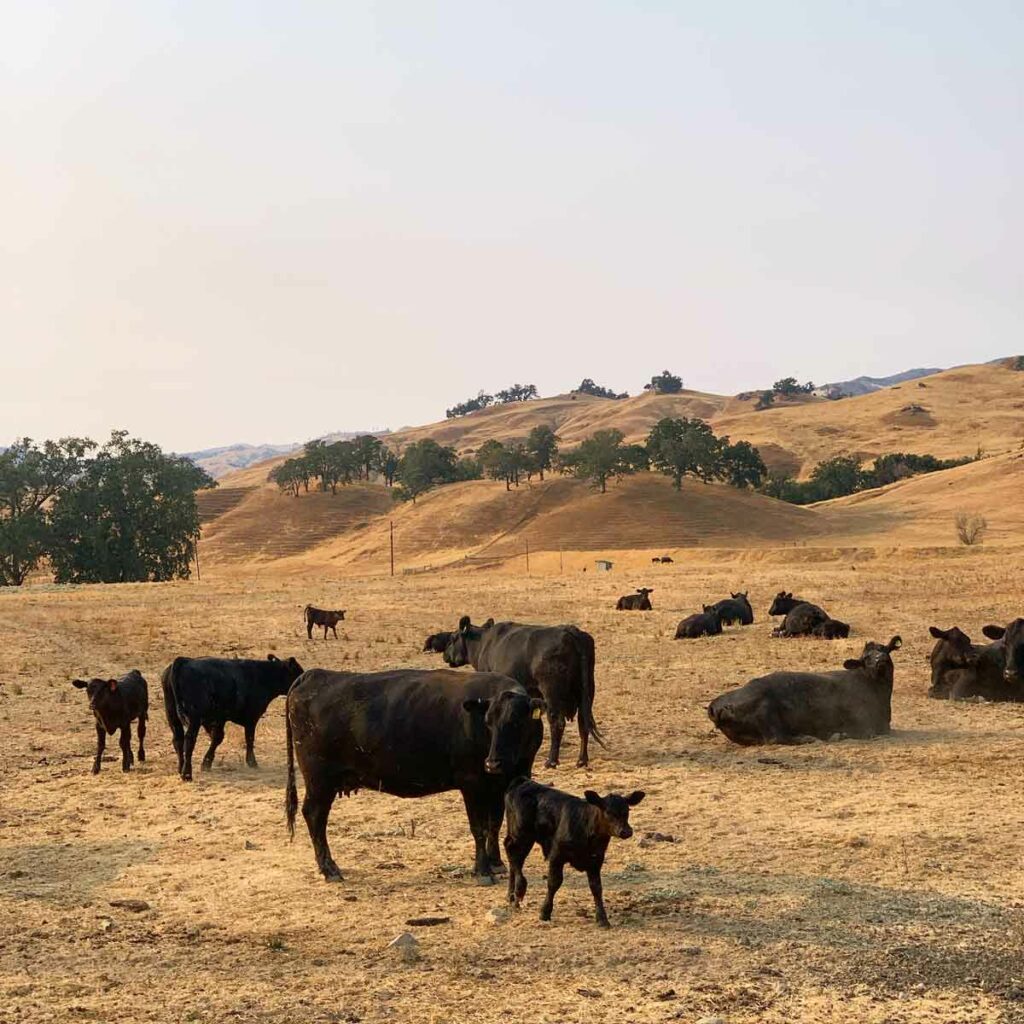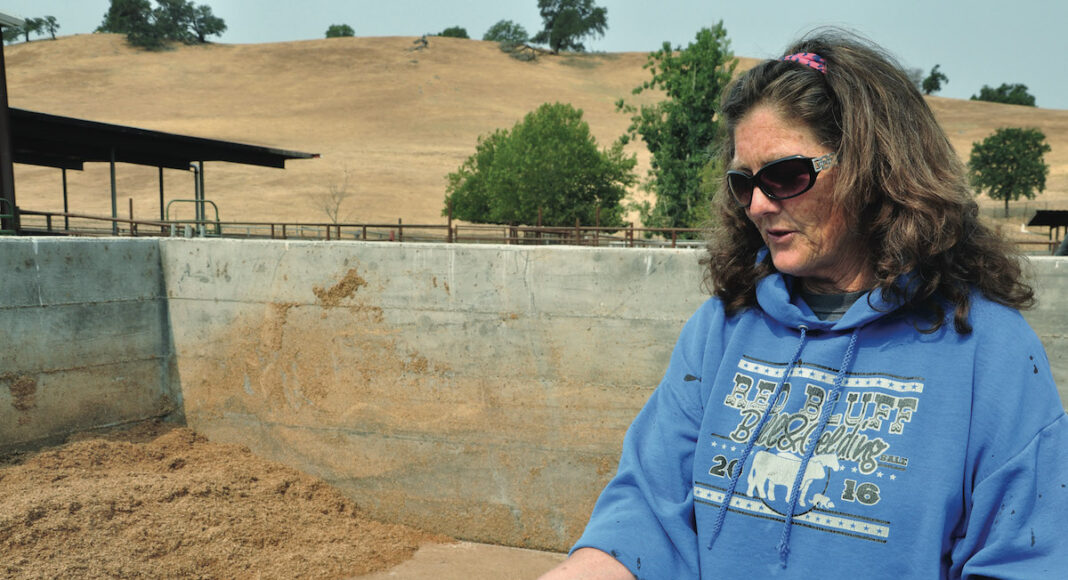Innovative organization provides hunger relief
Wildfires, floods and drought—it’s been a rough stretch for Northern California, even before the arrival of a pandemic. In Knight’s Valley outside of Calistoga, Cheryl LaFranchi of Oak Ridge Angus Ranch has seen it all, most notably the Kincaide Fire that left her house and several barns in ashes just two years ago.
“I swear to God, if I didn’t have a ranch, I’d be somewhere decent, that’s for damn sure,” she says. LaFranchi is kidding, of course—there’s no place she’d rather be, she admits with a smile, than on her resurrected ranch with her herd of cows, in the community where her family has lived and worked for more than three generations.
LaFranchi and her husband, Frank Mongini, a large-animal veterinarian, charged right into rebuilding their ranch shortly after the fire. With plenty of help from friends, family and local agriculture organizations, the two co-owners are back in the business of raising premium, pasture-fed and grain-finished cattle under their Oak Ridge brand.
But LaFranchi knows that beyond the ranch, the region’s successive challenges have overstretched the resilience of many communities—and their food security. For nearly a decade, she and her husband have spearheaded the Range to Table program, a barn-raising effort to beef up hunger relief through the Redwood Empire Food Bank. They corral local ranchers to donate cattle, fattening them up alongside their own herd on pasture grass and spent grain from a nearby brewery. Since 2012, the program has produced thousands of pounds of beef annually for low-income households throughout the North Coast.
“It’s a really innovative program,” ostensibly a first and one of a kind, says Food Bank CEO David Goodman. “Cheryl and Frank are bridging the world of ranching and hunger relief. They see the connection between their work and making sure that this high-quality food makes it to as many people as possible.” And they’re tightening the loop between ranchers, their land and their community by putting beef sourced locally and sustainably on a wide range of local tables.
Oak Ridge’s herd of 350 cattle spend most of the year grazing the rolling 1,200-acre ranch. “The Angus are an extremely hardy breed,” says LaFranchi, thumping the smooth rump of an ebony brown heifer, which bats its long eyelashes while giving her a sideways glance. “They’re tough in cold weather, they make great mothers and these cows love the hills,” she adds. And with ample range to roam, the low-stress environment keeps them healthy without antibiotics or hormones.
“It’s just a great cow ranch,” she says. There’s not enough water for crops, but the pastures get enough rain to grow native forage—hardy, drought-tolerant perennials like rye and clover—for a good part of the year. As the cows graze and trample the ground, they enrich the soil with organic waste, building nutrients and retaining more moisture. And they reseed the grass and clear away brush, creating a regenerative relationship between herd and pasture.


During the arid months when the land is parched, the cattle head down to the newly rebuilt, open-air barn, where they feed on haylage—bales of grass harvested in the spring. There beneath the shade, the troughs hold another incentive for them to descend the hills: freshly spent beer grain, courtesy of the Bear Republic Brewing Company, located in nearby Cloverdale.
The cows relish the moist mash of malted barley and wheat. “It’s a significant part of our operation,” LaFranchi says, holding up a hay-colored handful resembling rough, steel-cut oats. High in protein, amino acids and fiber, it supplements about a third of the herd’s feed, fattening them up while imparting rich flavor and deep marbling to the beef. She’s been hauling it in by the truckload several days a week since the brewery opened in 1996.
“We have a wonderful partnership,” says Bear Republic co-owner Tami Norgrove. Spent grain is their most abundant by-product, so the brew-moo symbiosis is “a sustainable way of making sure that we’re putting as little into the waste stream as possible.” By donating it to the ranch, she says, “we’ve never had to put it into landfill.”
LaFranchi usually picks up the grain just hours after it’s been brewed. It’s often still a bit warm, she notes, and the cows love the residual sweetness. As she pulls her truck up to the barn’s hangar-like canopy, there seems to be enough excitement over the day’s delivery to incite a minor stampede.
In an interior portion of the barn marked by a few remaining burnt posts, calves and mothers chew quietly, safely buffered from the hooves, hustle and occasional mooing of the larger group. There, some of the youngsters, including a pint-sized newborn with a soft auburn shag, duck under udders to nurse. But the older ones get a hefty share of brewers mash along with their haylage; packed with 22% protein, the supplemental feed gives the junior cows a healthy nutritional boost—and bulk.
LaFranchi has a soft spot for the “cute little pennies,” as she calls them, often taking in calves with special needs from other ranches. “If anybody has problems, whether the mom dies, they’re twins or they’ve been kind of chewed up by the coyotes,” she says, “they send them to us, and we give them a little extra love.”
Enter Sparky, who lost part of his nose and his tail back in the spring, in a gruesome nighttime attack. “I don’t know how Frank kept him alive, but he did,” LaFranchi says of her husband’s heroic veterinary intervention. Sparky is now a spry, seven-month-old calf, but the accident left him unable to nurse properly and consequently smaller and scrawnier than his peers.
For small-scale ranchers, outliers like Sparky—injured cattle, runts, orphans and calves with congenital defects—can impact their bottom line. “If you get cows that don’t fit your branded-beef program, you can’t sell them with your herd,” LaFranchi says. With premium cattle commanding premium prices at auction, it could devalue a cow by half, she notes, making the raising of misfits a costly proposition.
But “if you have cows that aren’t going to get you top dollar,” she says, “people can send them here, and they have a great life.” With beer grain defraying the cost of feed, those calves can bulk up alongside the herd while roaming the hilly pastures. And in a year or so, each head of cattle can provide the Redwood Empire Food Bank with up to 1,000 pounds of high-quality, locally sourced USDA beef.
That’s the premise of Range to Table: ranchers donate their undervalued cows to the program, receive a tax write-off from the Food Bank and maximize their impact on hunger relief in the local community.
Since its inception in 2012, nearly 40 regional ranchers have participated in the program, either through calves raised by LaFranchi—which she donates in their name—or through older cattle which have lost market value. “Everybody is beyond nice and very community-minded,” she says. Many have grown up locally, she adds, “and want to give back just a little.”
Contributions have steadily increased over the years, with large boosts during the Wine Country fires in 2017 and flooding in 2018, hitting an all-time record of 22,000 pounds of beef in 2019. Bottlenecks in meat processing during the pandemic brought donations down to a respectable 8,500 pounds last year, but LaFranchi is hoping for a bullish rebound as the industry normalizes.
Meanwhile, the need for food assistance has doubled since 2020, states the Food Bank’s Goodman, whose organization serves Sonoma, Lake, Mendocino, Humboldt and Del Norte counties. And each calamity, he adds, leaves a long wake of economic uncertainty in the region. “But whether it’s natural disasters—fires or floods—or human disasters like a federal shutdown or a global pandemic, it’s all the same,” he says. “Hunger doesn’t really care what the reason is.”
For Goodman, being able to offer nutritious protein—what he calls “center of plate” foods—is invaluable. “Beef is highly prized and very expensive, so it’s tremendous when we [can] provide that.” In the spirit of equality, the whole cow, prime cuts and all, is churned into ground beef. “It just stretches so much further,” he says. “You don’t want hamburger while the other person gets filet mignon, so this makes everybody happy.”
It’s a novel program, he notes, one that builds local resilience through a full circle of locally sourced resources. “I have this vision that this should be in every community, every state where there’s ranching,” he says. But in a profession that’s particularly vulnerable to uncertainty, Goodman recognizes that it takes dedication and a tough resolve to keep up the effort.
“Gratitude isn’t what fuels them,” he says of LaFranchi and Mongini. “Their fuel comes from within, just doing community good.” And, he emphasizes, “they continued to keep Range to Table alive after the [Kincaide] fire, when most people would have just folded up shop.”
Back at the ranch, “around here, there’s always something,” LaFranchi says. This year, she’s been trucking in 90,000 gallons of water a week since her ponds and springs dried up over the summer. “So much depends on what happens,” she says, “and you end up having to do things that you’d never, ever thought you’d have to do.”
But the pragmatic rancher isn’t one to ruminate on adversity. “[Ranching] isn’t exactly monetarily rewarding,” she says, “but it’s a great way of life, I’m not going to lie to you.” And with her herd of cattle, endless rolling pastures and a supportive community, she adds, “we’re just in a very fortunate situation to be able to make an impact.”
Naoki Nitta is a food and sustainability writer based in San Francisco.











